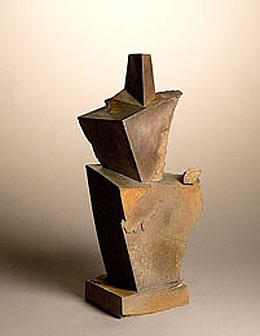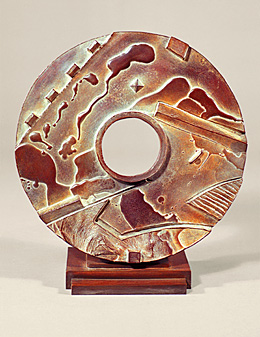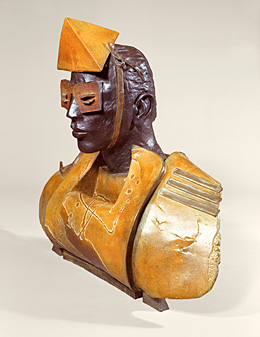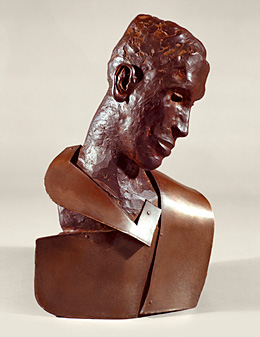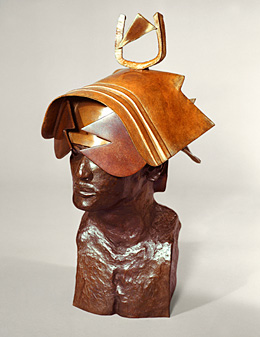|
|
|
|
|
|
|
|
|
|
|||||||||||||||
|
|
|||||||||||||||||||||||
Retrospective Review, 2004 |
|||||||||||||||||||||||
The Road of an Artist: Trail Markers
|
|||||||||||||||||||||||
Roger Arvid Anderson’s 25-year retrospective at Dovetail Design is an exploration of themes that are of both the antique world and the psychological motifs of the New Age. Anderson, a Bay Area sculptor, has created works of cast bronze that combine expert craftsmanship with unusual subject matter that ranges from a bust of Bucephalus, Alexander the Great’s famous horse, to abstract landscapes of Mount Shasta. The pieces are innovative and thought provoking, but above all, beautifully rendered. Anderson uses a “lost wax” bronze-casting system wherein the pieces are sculpted of wax that burns off in the casting. In his artist statement, Anderson describes this system as a “stylistic mix of modeling and construction” that allows him to achieve a detail-oriented, multilayered sculpture. The purest example of the benefits of this technique is the stunning “Meritaten” piece. Meritaten, the teenage daughter of Nefertiti, who assumed the role of queen in her early adolescence, is poignantly caught between nobility and the frailties of youth. Her slender shoulders are draped in a bronze cloak, while her haughty, linear features reveal a regal poise beyond her tender years. It’s an interesting juxtaposition, but the selling point of the piece is its artistic details. Elongated, Egyptian symbols adorn her neck and forehead, but her eyes, nose, lips and chin are chillingly and perfectly sculpted from the wax model. Anderson’s clean lines are similarly evident in the aforementioned “Bucephalus.” The horse-head design is, again, elongated and thin, but there is an almost human aspect to the eyes. This sculpture would seem to capitalize on Alexander’s well-known sorrow at his horse’s death rather than on a simple equine representation. The elegant curve to the neck that bows downward is played against the cocked ears and forward-looking eyes to create a sense of delayed utility and absent purpose. “Hannibal” and “The Poet” are bookend pieces that represent the active and the contemplative respectively. Both are steeped in the classical design, but the rough-hewn wax head of the poet intimates a fevered working that parallels the hard lines of the warrior. In his “Trail Markers” series, Anderson offers abstract, geometrically shaped landscapes. In “Mt. Shasta,” odd-sized shapes -- rectangles, parallelograms and triangles -- are piled atop one another at gravity-defying angles. The result is a mountainesque shape that is complete with a playful nod to the New Age lore that surrounds Mount Shasta. “California Zen Master” is another melding of New Age and tradition. The bust is classical in design but decked out in antique armor, a goofy triangle-shaped party hat and Devo-style sunglasses. These lighthearted elements are fancifully paired against the weighty material to attain a comic sensibility of the California New Age movement. A series of discs titled “Metaphysical Landscapes” play with aerial views inspired by ancient Chinese jade discs. Anderson explains that the center hole in each piece is called “bi” and that the shape is “regarded as a symbol of heaven” in Chinese art. The pieces reveal themselves as laden with symbolism yet void of heavy dogma. Because of this fine balance, the nuances and decorative elements become more intriguing the longer one looks, and these discs truly appear to hinge between representation and metaphysics. The curatorial choice to tuck these pieces into available nooks around the gallery detracts from their dreamy eloquence and makes them, unfortunately, seem almost secondary to their larger, prominently displayed counterparts. The layout of the gallery space forces Anderson’s work to be spread throughout the three exhibit rooms and alongside numerous pieces from the permanent collection. This is often distracting. Anderson’s work has a unified, thematic arc that builds from the historical to the contemporary and is carried off by the organic materials of its composition. Breaking the flow of this movement is a disservice to the work. But, in the end, exquisite craftsmanship wins out over spatial complaints, and Anderson’s work is a superior example of bronze-casting sculptures. |
|
||||||||||||||||||||||
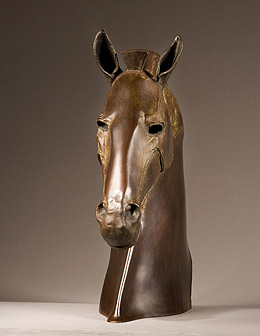 BUCEPHALUS, 1983 bronze |
|||||||||||||||||||||||
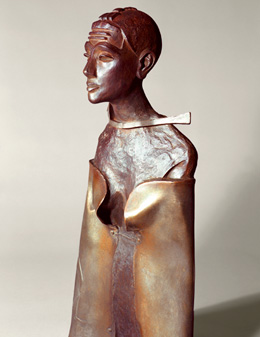 MERITATEN, 1981 bronze |
|||||||||||||||||||||||
|
|||||||||||||||||||||||
